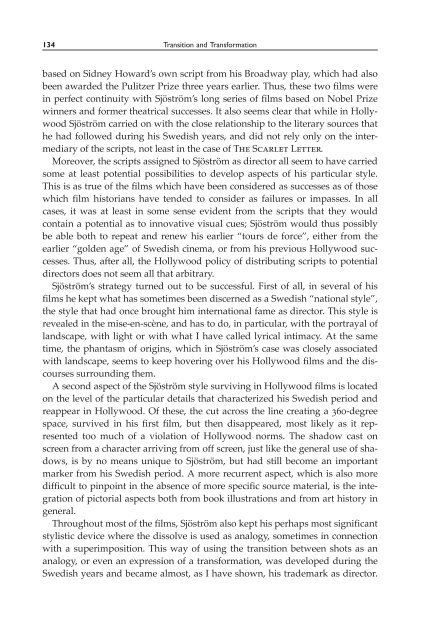FILM FILM - University of Macau Library
FILM FILM - University of Macau Library
FILM FILM - University of Macau Library
You also want an ePaper? Increase the reach of your titles
YUMPU automatically turns print PDFs into web optimized ePapers that Google loves.
134 Transition and Transformation<br />
based on Sidney Howard’s own script from his Broadway play, which had also<br />
been awarded the Pulitzer Prize three years earlier. Thus, these two films were<br />
in perfect continuity with Sjöström’s long series <strong>of</strong> films based on Nobel Prize<br />
winners and former theatrical successes. It also seems clear that while in Hollywood<br />
Sjöström carried on with the close relationship to the literary sources that<br />
he had followed during his Swedish years, and did not rely only on the intermediary<br />
<strong>of</strong> the scripts, not least in the case <strong>of</strong> The Scarlet Letter.<br />
Moreover, the scripts assigned to Sjöström as director all seem to have carried<br />
some at least potential possibilities to develop aspects <strong>of</strong> his particular style.<br />
This is as true <strong>of</strong> the films which have been considered as successes as <strong>of</strong> those<br />
which film historians have tended to consider as failures or impasses. In all<br />
cases, it was at least in some sense evident from the scripts that they would<br />
contain a potential as to innovative visual cues; Sjöström would thus possibly<br />
be able both to repeat and renew his earlier “tours de force”, either from the<br />
earlier “golden age” <strong>of</strong> Swedish cinema, or from his previous Hollywood successes.<br />
Thus, after all, the Hollywood policy <strong>of</strong> distributing scripts to potential<br />
directors does not seem all that arbitrary.<br />
Sjöström’s strategy turned out to be successful. First <strong>of</strong> all, in several <strong>of</strong> his<br />
films he kept what has sometimes been discerned as a Swedish “national style”,<br />
the style that had once brought him international fame as director. This style is<br />
revealed in the mise-en-scène, and has to do, in particular, with the portrayal <strong>of</strong><br />
landscape, with light or with what I have called lyrical intimacy. At the same<br />
time, the phantasm <strong>of</strong> origins, which in Sjöström’s case was closely associated<br />
with landscape, seems to keep hovering over his Hollywood films and the discourses<br />
surrounding them.<br />
A second aspect <strong>of</strong> the Sjöström style surviving in Hollywood films is located<br />
on the level <strong>of</strong> the particular details that characterized his Swedish period and<br />
reappear in Hollywood. Of these, the cut across the line creating a 360-degree<br />
space, survived in his first film, but then disappeared, most likely as it represented<br />
too much <strong>of</strong> a violation <strong>of</strong> Hollywood norms. The shadow cast on<br />
screen from a character arriving from <strong>of</strong>f screen, just like the general use <strong>of</strong> shadows,<br />
is by no means unique to Sjöström, but had still become an important<br />
marker from his Swedish period. A more recurrent aspect, which is also more<br />
difficult to pinpoint in the absence <strong>of</strong> more specific source material, is the integration<br />
<strong>of</strong> pictorial aspects both from book illustrations and from art history in<br />
general.<br />
Throughout most <strong>of</strong> the films, Sjöström also kept his perhaps most significant<br />
stylistic device where the dissolve is used as analogy, sometimes in connection<br />
with a superimposition. This way <strong>of</strong> using the transition between shots as an<br />
analogy, or even an expression <strong>of</strong> a transformation, was developed during the<br />
Swedish years and became almost, as I have shown, his trademark as director.

















